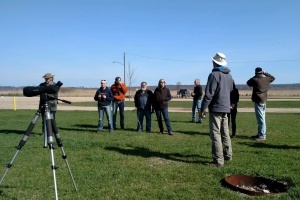Wetlands Month featured wetland: Manistee Marsh
May is American Wetlands Month – a month to appreciate and enjoy the wonders of wetlands!
 Explore one of Michigan’s finest wetlands – the Manistee Marsh at the Manistee River State Game Area in Manistee. Explore one of Michigan’s finest wetlands – the Manistee Marsh at the Manistee River State Game Area in Manistee.
The Manistee River State Game Area encompasses nearly 4,000 acres of wetland, forest and grassland habitats. The Manistee Marsh, on the west end of the game area, includes the eastern shore of Manistee Lake and is bordered by the Manistee River.
The marshland and adjacent forestland makes great habitat for wood ducks. Wood ducks nest in tree cavities and dine on acorns, seeds, berries and insects on the forest floor in addition to aquatic plant and insect foods.
Plenty of other wetland species call Manistee Marsh home. The marshlands provide important habitat for nesting and migrating ducks, geese, herons, terns and other wetland birds. The marshes are also home to muskrats, mink, frogs, turtles, snakes and many other wetland critters.
Work is under way to remove invasive species, including phragmites, in the marsh. Phragmites australis, also known as common reed, is a perennial wetland grass that can grow to 15 feet in height. Invasive phragmites creates tall, dense stands that degrade wetlands and coastal areas by crowding out native plants and animals, blocking shoreline views, and reducing access for swimming, fishing and hunting. The dry plant material from phragmites also can create fire hazards.
 The Manistee Marsh restoration project is funded by a Great Lakes Restoration Initiative grant. This work will improve plant diversity in the marsh, and reducing the phragmites cover will allow managers to create what’s called a “hemi-marsh” – a 50/50 mix of vegetation and open water that is very attractive to waterfowl. The Manistee Marsh restoration project is funded by a Great Lakes Restoration Initiative grant. This work will improve plant diversity in the marsh, and reducing the phragmites cover will allow managers to create what’s called a “hemi-marsh” – a 50/50 mix of vegetation and open water that is very attractive to waterfowl.
These wetlands are open to hiking, canoeing, kayaking, wildlife photography, fishing and birding. Bring a lunch and make a day of exploring the wetlands of Manistee Marsh.
Michigan’s state game and wildlife areas are free to wildlife watchers. Hunting license fees pay for habitat management at these areas. Even if you are not a hunter in the traditional sense, consider purchasing an $11 base license to benefit the creatures you hunt with your binoculars, cameras and spotting scopes.
/Note to editors: Contact – Holly Vaughn, 313-396-6863. An accompanying photo is available below for download. A suggested caption follows.
Bird tour participants enjoy the sights at Manistee Marsh./
The Michigan Department of Natural Resources is committed to the conservation, protection, management, use and enjoyment of the state’s natural and cultural resources for current and future generations. For more information, go to www.michigan.gov/dnr.
|